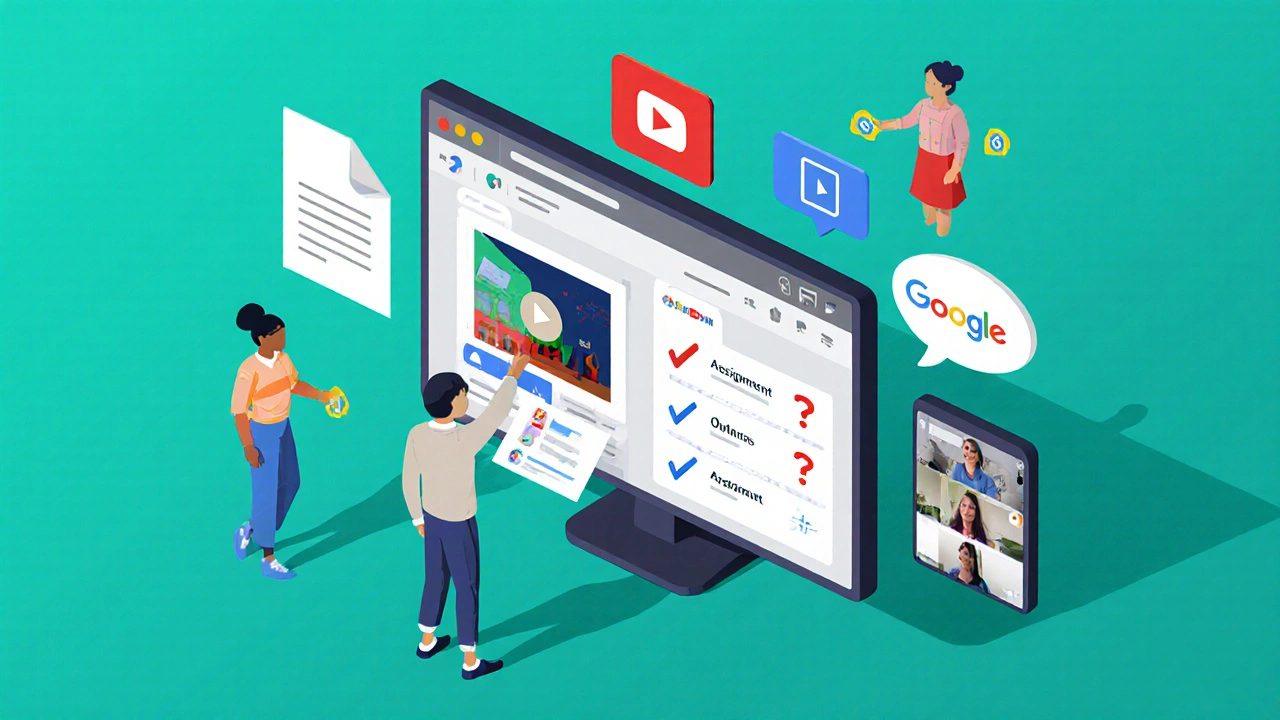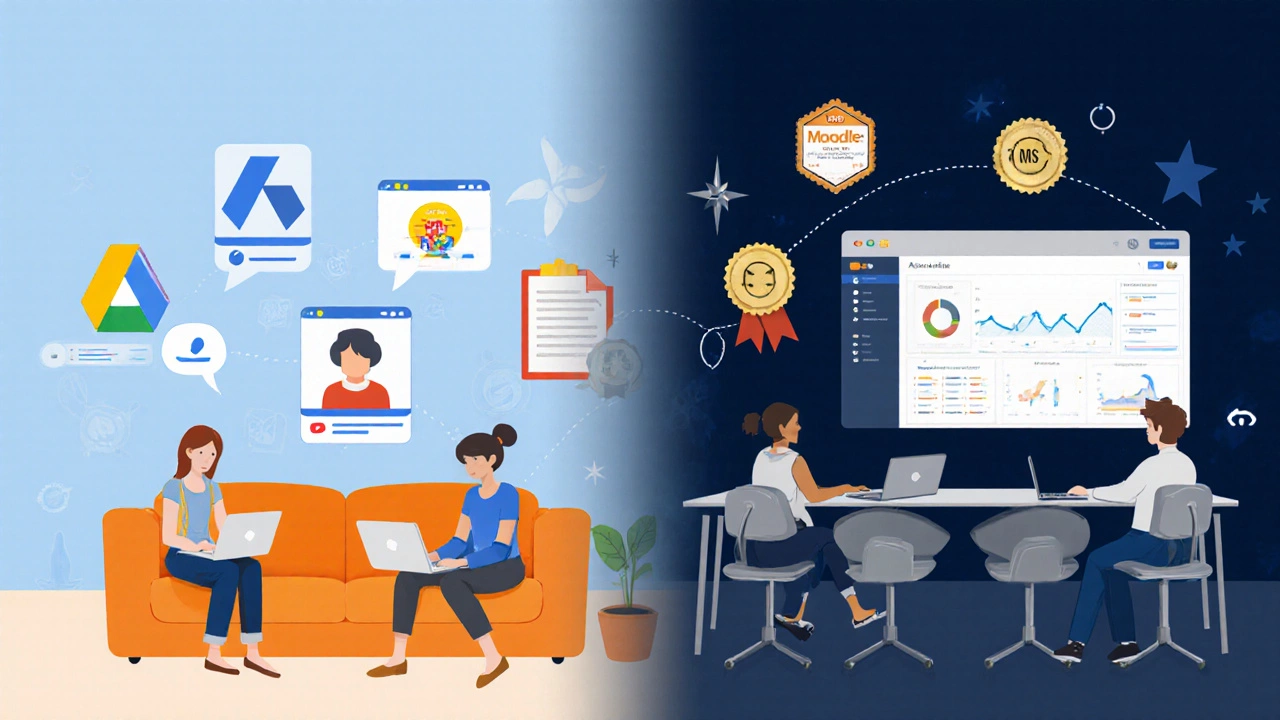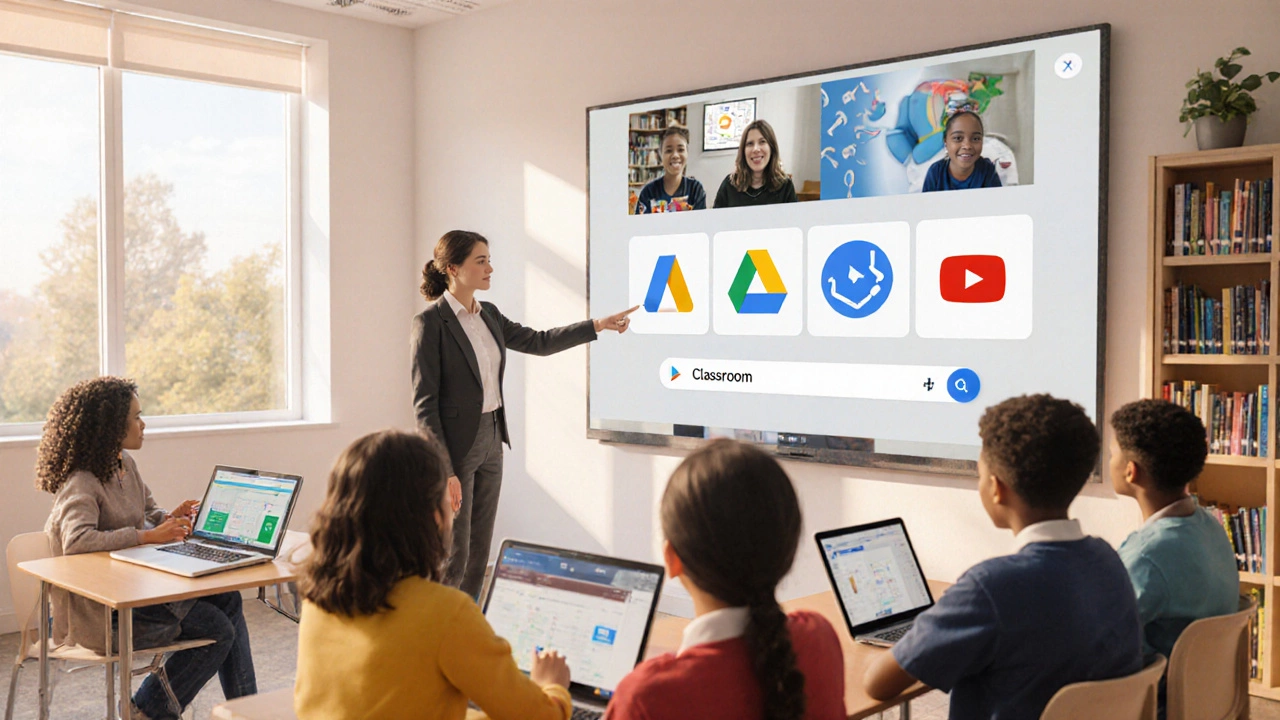Google LMS Suitability Calculator
Answer the questions above to get a recommendation.
When you type Google a multinational tech giant that offers a suite of free tools for education and collaboration, it’s easy to assume the company is just a search engine. But over the past decade Google has built a whole ecosystem that many teachers and students treat like an e‑learning platform. This article breaks down exactly what Google provides for learning, how it stacks up against purpose‑built platforms, and whether you should rely on it for your courses.
Quick Takeaways
- Google offers a collection of free tools-Classroom, Meet, YouTube, Search, Scholar-that together cover most basic e‑learning needs.
- It lacks built‑in LMS features like advanced analytics, certification, and structured curricula that platforms such as Coursera or Moodle provide.
- For K‑12 schools or small‑scale corporate training, Google’s suite can be a cost‑effective starter.
- When you need paid certifications, drip‑feed content, or deep integration with third‑party apps, a dedicated LMS is usually a better fit.
- Use the checklist at the end to decide if Google alone meets your learning goals.
What Makes an E‑Learning Platform?
An e‑learning platform (or Learning Management System, LMS) typically offers three core capabilities:
- Content creation and delivery - upload videos, PDFs, quizzes, and organize them into modules.
- Student management - enroll learners, track progress, generate reports.
- Interaction tools - discussion boards, live video, assignments, grading.
Any solution that checks most of these boxes can be called an e‑learning platform, even if it’s a collection of separate tools.
Google’s Education Suite
Google Classroom a free LMS‑like service that lets teachers create classes, distribute assignments, and give feedback is the centerpiece. It integrates tightly with other Google services:
- Google Meet for live video sessions.
- YouTube for hosting lecture videos.
- Google Drive for file storage and sharing.
- Google Docs, Sheets, Slides for collaborative assignments.
- Google Search and Google Scholar for research.
All of these tools are cloud‑based, work on any device, and require no additional licensing for basic use.
Deep Dive: Google Classroom
Google Classroom handles the three LMS pillars, albeit in a simplified form:
- Content delivery: Teachers post announcements, attach Drive files, embed YouTube videos, or share links.
- Student management: Class codes let learners self‑enroll; the teacher sees a roster, can organize students into groups, and set due dates.
- Interaction: Built‑in commenting, private feedback, and integration with Meet for live lessons.
What it doesn’t provide out‑of‑the‑box are advanced grading rubrics, competency tracking, or built‑in e‑commerce for paid courses. Those gaps can be patched with third‑party add‑ons, but they never become as seamless as a purpose‑built LMS.
Other Google Tools That Fill Gaps
When Classroom falls short, educators often reach for these companions:
- YouTube the video‑sharing platform that supports playlists, live streaming, and private unlisted videos - ideal for hosting lecture recordings.
- Google Meet a video‑conference service with screen‑share, real‑time captions, and breakout rooms - useful for webinars and office hours.
- Google Scholar a specialized search engine for scholarly articles, theses, books, and conference papers - helps learners find credible sources.
- Google Forms a survey tool that doubles as a quiz engine with automatic grading - convenient for quick assessments.
All these services respect the same single sign‑on (SSO) system, so students and teachers manage just one Google account.

How Google Stacks Up Against Dedicated Platforms
| Platform | Course creation | Assessment tools | Analytics & reporting | Pricing model | Mobile app |
|---|---|---|---|---|---|
| Google Classroom | Simple folder‑based upload; integrates with Drive | Basic quizzes via Forms; manual grading | Limited; basic completion status | Free for education (G Suite for Education) | iOS & Android native app |
| Coursera | Professional course authoring tools, video‑first | Auto‑graded quizzes, peer‑review, certificates | Detailed learner dashboards, cohort analytics | Free audit; paid certificates, subscription plans | iOS & Android app with offline download |
| Moodle | Open‑source, highly customizable course builder | Extensive quiz engine, competency frameworks | Robust reporting, plugins for advanced analytics | Self‑hosted (free) or paid hosting services | Responsive web; third‑party mobile apps |
| Khan Academy | Pre‑made content; limited teacher customization | Embedded practice exercises, mastery tracking | Progress reports for students & teachers | Completely free | iOS & Android app with offline mode |
From the table you can see Google shines in accessibility and cost, but it lags on deep analytics, certification, and e‑commerce features. If your program needs rigorous compliance reporting or paid credentials, a dedicated LMS will save you time.
Pros and Cons of Using Google as Your E‑Learning Platform
Pros
- Zero licensing cost for schools that qualify for G Suite for Education.
- Familiar interface - most students already use Gmail and Drive.
- Real‑time collaboration on Docs, Sheets, Slides.
- Scalable storage (15GB per user, unlimited for education accounts).
- Seamless video integration via Meet and YouTube.
Cons
- No built‑in monetization or certificate issuance.
- Limited analytics - you can see who submitted work, but not detailed engagement metrics.
- Course structure is linear; no branching or competency maps.
- Reliance on internet connectivity; offline access is patchy.
- Data residency is controlled by Google, which may raise privacy concerns for some institutions.
When to Choose Google Over a Dedicated LMS
Consider Google if you meet at least one of these criteria:
- You run a K‑12 school or a small nonprofit with limited budget.
- You need quick rollout - a teacher can set up a class in minutes.
- Your curriculum is mainly document‑based (PDFs, Slides) with occasional video.
- You already use Google Workspace for email and calendar.
- You don’t require paid certificates or advanced compliance reporting.
If you need any of the features listed in the “Cons” section, start looking at Coursera, Moodle, or a paid LMS like Canvas.
Checklist for Educators: Is Google Enough?
- Do you need automated grading beyond multiple‑choice? Yes → add Google Forms or switch platforms.
- Will you issue official certificates? Yes → consider a platform that issues badges.
- Is data privacy a legal requirement (e.g., GDPR, FERPA)? Yes → review Google’s education compliance documentation.
- Do you require detailed learner analytics? Yes → add a third‑party analytics add‑on or migrate.
- Is offline access critical (e.g., remote areas with spotty internet)? Yes → consider a LMS with native offline sync.
Answering “yes” to two or more items usually signals that Google alone won’t cut it.

Real‑World Example: A Sydney High School’s Switch
In 2023 a public high school in Sydney piloted Google Classroom for its Year10 science program. Within a semester they reported 20% higher assignment submission rates because students could access resources from any device. However, the school later added Moodle for its senior vocational courses, citing the need for competency tracking and industry‑linked certificates. The hybrid approach let them keep the low‑cost benefits of Google while getting the heavy‑duty features from Moodle where needed.
Future Outlook
Google continues to invest in education. In 2024 they introduced AI‑assisted question generation in Classroom and tighter integration with the new Google Workspace Labs that experiment with adaptive learning pathways. These updates narrow the gap but still won’t replace the depth of specialized LMSs. Expect Google to remain a solid “starter kit” for schools, while larger institutions keep mixing in dedicated platforms.
Bottom Line
Google is not a traditional e‑learning platform in the sense of Coursera or Moodle, but its suite of free tools collectively forms a functional, low‑cost solution for many learning scenarios. Whether it’s the right choice depends on your specific needs-budget, features, compliance, and scalability. Use the checklist above to decide, and don’t be afraid to blend Google with a purpose‑built LMS if you need the best of both worlds.
Frequently Asked Questions
Is Google Classroom a full LMS?
Google Classroom covers the basics-content posting, assignment collection, and simple grading-but it lacks advanced features like built‑in certifications, deep analytics, and extensive course branching. It works well for K‑12 and small corporate training.
Can I charge students for courses using only Google tools?
Google itself does not provide a payment gateway or certificate issuance. You would need a third‑party service (e.g., PayPal, Stripe) and manually issue certificates, or switch to a platform that handles monetization out‑of‑the‑box.
How does Google handle student data privacy?
Google Workspace for Education is compliant with FERPA and GDPR. Data is stored in Google’s global data centers, and administrators can control sharing settings. Schools should review Google’s Education Data Processing Amendment for specifics.
Can I integrate Google Classroom with other LMSs?
Yes, through LTI (Learning Tools Interoperability) bridges or Zapier automation. However, integration can be limited and may require technical support.
What are the best alternatives if Google falls short?
Consider Coursera for credentialed courses, Moodle for open‑source flexibility, or Canvas for a modern, enterprise‑grade LMS. Each offers stronger analytics, certification, and payment features.

